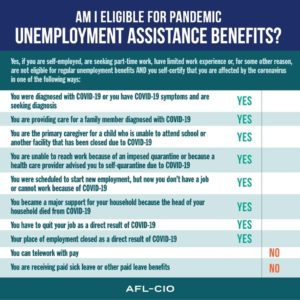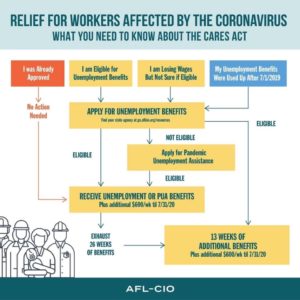COVID-19 IL Unemployment Information
IDES Taking Steps to Address Unprecedented Volume of Unemployment Claims
Local 219 General Membership
This page has been established to provide you with resources realted to unemployment due to the COVI-19 virus. We will do our best to communicate pertinent information in a timely fashion.
The top of this page will give you specific resource links. The body below will be an at large membership message.
April 9, 2020 – Update
If you have any questions or concerns about filing about unemployment please check out the links below.
What Every Worker Should Know About Unemployment Insurance
April 6, 2020 – Update


March 27, 2020 – Update
US Government COVID-19 relief legislation
WORKER-RELATED PROVISIONS
Unemployment Insurance in the FFCRA – the FFCRA makes it easier for individuals to apply for unemployment insurance (UI) I because it provided $1 billion in grants to help states administrate their unemployment compensation programs. An amount of $500 million is available to any state that takes certain steps to facilitate applying for UI in at least two of the following ways: in-person, by phone or online. An amount of $500 million is also available to states that experience a 10% increase in unemployment and that ease eligibility requirements for applicants impacted by COVID-19 by waiving work search requirements and eliminating the waiting week. If states receive any amount of this grant money, it will make it easier for workers to apply for unemployment insurance.
Unemployment Insurance in the CARES Act – the CARES Act expands UI programs administered by the states in four ways: (1) expands access to UI benefits; (2) increases the amount of UI payments; (3) extends the duration of UI benefits; and (4) eliminates waiting periods. The changes only go into effect if a state enters an agreement with the federal government agreeing to certain terms. However, because the federal government is offering to pay for 100% of the changes allowed by the bill, there is little reason for states not to offer these expanded benefits.
Here is a summary of how the CARES Act will positively impact workers who are receiving or will apply for UI benefits.
For workers who qualify for regular UI benefits:
• All weekly UI benefits will be increased by $600 for the next four months (through July 31);
• State-law mandated “waiting periods” are waived;
• Benefits can be received for an additional 13 weeks beyond what state law typically allows; and
• These enhancements are for unemployment for any reason – not just COVID-19.
For workers who typically would not qualify for regular UI benefits:
• Access to the UI system is expanded – individuals who have exhausted their benefits, independent contractors, sole proprietors, those without a wage history, and others who usually would not qualify for UI benefits are eligible for regular UI payments;
• These individuals may receive benefits if they are unemployed or unavailable to work because of COVID-19 (but otherwise would be available for work);
• These workers are entitled to up to 39 weeks of UI benefits (including any benefits they received under regular UI);
• All weekly UI benefits will be increased by $600 for the next four months (through July 31); and
• State-law mandated “waiting periods” are waived.
For people who are eligible for regular UI, the increased benefits begin when the state enters into an agreement with the federal government. For people who are not otherwise eligible for UI, but are now eligible, because of the CARES Act, the benefits begin with weeks of unemployment after January 27, 2020. Regardless, these changes to UI are in addition to the direct payments described below in this memo.
The following is a more detailed summary from the CARES Act explaining specific UI provisions in the bill. The summary above is taken from these more specific details of the unemployment insurance provisions in the bill. In short, this is a deeper dive.
Increased UI Payments
• The bill increases the amount of UI benefits workers receive each week by $600, from the time the state enters into an agreement with the Federal Government through July 31st.
• This extra $600/week will be sent to workers receiving regular/extended UI benefits, as well as workers receiving benefits under the expanded access and duration provisions of the new bill.
• The extra $600 may be included in the weekly UI payment, or sent as a separate, weekly payment.
• These payments are in addition to the $1,200/$2,400 direct payments provided for elsewhere in the bill that are not tied to the UI system.
Increased Access to UI
• This bill allows those who have exhausted their rights to UI or would typically be ineligible to receive UI benefits if they are unemployed or unavailable for work for of COVID-19-related reasons but would otherwise be able to and available for work.
• Examples of who will be eligible for UI under this section include the self-employed (e.g., independent contractors) and those who would normally not have a sufficient wage history to receive UI.
• Workers receiving benefits under this section will receive the weekly payments they would receive if they were eligible for regular UI, plus the extra $600/week described above.
• Generally speaking, workers can earn up to 39 weeks of UI payments under this section, including any weeks of UI they have already used.
• Any state-mandated waiting periods are waived for purposes of this benefit.
• States can use any evidence of prior earnings to calculate the amount of weekly benefit payments owed an individual. If someone does not produce sufficient evidence of prior earning history for a determination of weekly benefits to be made, they can instead earn a “minimum flat benefit” based on the average weekly payments made in the state.
• This benefit is not available to anyone who has the ability to telework with pay or is receiving paid sick leave or other paid leave benefits. If an individual remains out of work because of COVID-19 after exhausting their paid leave, they can then apply for these UI benefits.
Increased Duration of Regular UI
• The bill allows states to extend the length of UI benefits for workers who are eligible for regular or extended UI. In most cases, this allows for an extra 13 weeks of benefit payments. (Note that this extension is not available to individuals receiving benefits under Section 2102’s new expanded access rules.)
• To be eligible, an individual must exhaust all their rights to regular/extended UI under state law and must be actively seeking work.
• Individuals receiving benefits under this section will receive the extra $600/week provided by section 2104, until July 31, 2020.
• Anyone who is eligible for benefits under this section must use up these benefits before receiving payments under the expanded access provision (section 2102).
Waiting Periods Are Waived
• The bill offers states a powerful economic incentive to waive their state-law mandated “waiting periods” that prevent people from immediately receiving UI benefits.
• The federal government offers to pay for 100% of the total amount of regular UI benefits states pay to individuals for their first week of regular unemployment if states agree to waive these “waiting periods” through the end of 2020.
Examples – the following are anticipated real life scenarios of how the CARES Act will impact building trades men and women.
1. Jane Doe, a pipefitter, is laid off because the project site she was working on has been shut down due to Covid-19. She reported that she earned $60,000 of income on her most recent tax return, and she is eligible for regular UI benefits because she was an employee and has a prior earning history. She will receive: (1) her weekly UI benefits, which are a percentage of her prior salary, plus (2) an extra $600 per week (through July 31), plus (3) a $1,200 tax credit. Her state normally limits allows 26 weeks up to 39 weeks of regular and extended UI benefits and applies a “waiting week” before benefits are sent. Under the CARES Act, she will be able to receive benefits immediately and for up to 52 weeks because of this bill.
2. John Smith is a first-year apprentice operating engineer. He started his apprenticeship in September but was laid-off in February because of COVID-19-related work slowdowns. He reported an income of $20,000 on his most recent tax return. In normal circumstances, he would be denied UI under his state’s eligibility rules because of a lack of work history. Under the CARES Act, the state would be able to use any documentation he submits of his earnings during his apprenticeship to calculate an appropriate weekly benefit. He will receive: (1) weekly UI benefits based on the pay stubs that establish his pre-layoff wages, plus (2) an extra $600 per week (through July 31), plus (3) a $1,200 tax credit. He can receive these weekly UI benefits for up to 39 weeks, as long as his unemployment continues to be caused by COVID-19.
3. Jill Jones is an electrician who has been out of the workforce for a few years but was hired to start on a project at the end of March. This project was delayed because of COVID-19. While Jill would not typically be eligible for UI because of her lack of wage history, she can now apply for benefits because of the expanded access provisions of this bill. Because she did not report any income on her most recent tax return and has no wage history that can be used to calculate a weekly benefit amount, she will receive: (1) a “minimum flat benefit” based on the average weekly benefit paid in the state, plus (2) an extra $600 per week (through July 31), plus (3) a $1,200 tax credit. She will start receiving this benefit immediately because the state has waived its waiting period.
The US Government COVID-19 relief legislation information was provided to us from NATBU
March 18, 2020
COVID-19 and Unemployment Benefits
Unemployment benefits may be available to some individuals whose unemployment is attributable to COVID-19. IDES recently adopted emergency rules to try to make the unemployment insurance system as responsive to the current situation as possible.
In general, Unemployment Insurance provides temporary income maintenance to individuals who have been separated from employment through no fault of their own and who meet all eligibility requirements, including the requirements that they be able and available for work, register with the state employment service and actively seek work. Below are some COVID-19 specific UI concerns.
Timeliness of UI benefits – In the Governor’s executive order 2020-07, the one week waiting period for UI claims has been suspended for claimants who are unemployed and otherwise eligible for UI benefits.
Laid off from job due to COVID-19 – An individual temporarily laid off because the place where they work is temporarily closed because of the COVID-19 virus could qualify for benefits as long as he or she was able and available for and actively seeking work. Under emergency rules IDES recently adopted, the individual would not have to register with the employment service. He or she would be considered to be actively seeking work as long as the individual was prepared to return to his or her job as soon the employer reopened.
Quitting a job over COVID concerns – An individual who leaves work voluntarily without a good reason attributable to the employer is generally disqualified from receiving UI. The eligibility of an individual in this situation will depend on whether the facts of his or her case demonstrate the individual had a good reason for quitting and that the reason was attributable to the employer. An individual generally has a duty to make a reasonable effort to work with his or her employer to resolve whatever issues have caused the individual to consider quitting.
Home confinement – If individuals are confined their home 1) because a licensed physician has diagnosed them as having COVID-19 or 2) because they must stay home to care for a spouse, parent or child, whom a medical professional has diagnosed as having COVID-19 or 3) because of a government-imposed or government-recommended quarantine, they would be considered to be unemployed through no fault of their own. However, to qualify for UI, they would still need to meet all other eligibility requirements, including the requirements that the individual be able and available for work, registered with the state employment service and actively seeking work from the confines of their home. The individual would be considered able and available for work if there was some work that he or she could perform from home (e.g., transcribing, data entry, virtual assistant services) and there is a labor market for that work.
Left work due to school closures – Ordinarily, an individual who left work to address childcare needs would be considered to have left work voluntarily and would generally be disqualified from receiving UI, unless the reason for leaving was attributable to the employer. However, the fact that all schools statewide have temporarily closed in response to the COVID-19 virus presents a unique situation in which it is unlikely a parent whose child cannot stay home alone has a ready alternative to staying home with the child himself/herself. Under the current circumstances, someone who left work to care for the child could be considered as unemployed through no fault of his her own; in that case, to qualify for UI, the individual would still need to meet all other eligibility requirements, including the requirements that the individual be able and available for work, registered with the state employment service and actively seeking work from the confines of his or her home. The individual would be considered able and available for work if there was some work that he or she could perform from home (e.g., transcribing, data entry, virtual assistant services) and there is a labor market for that work.
Additional benefits – At this point, no additional UI is available to individuals who have already received the full 26 weeks’ worth of benefits for their current benefit years.


